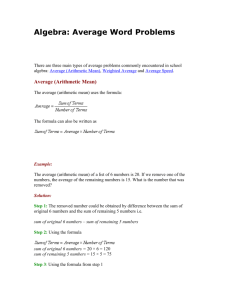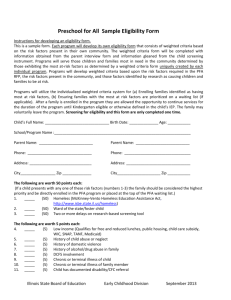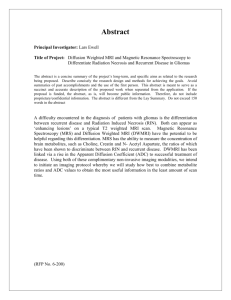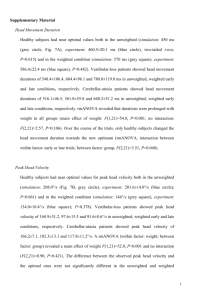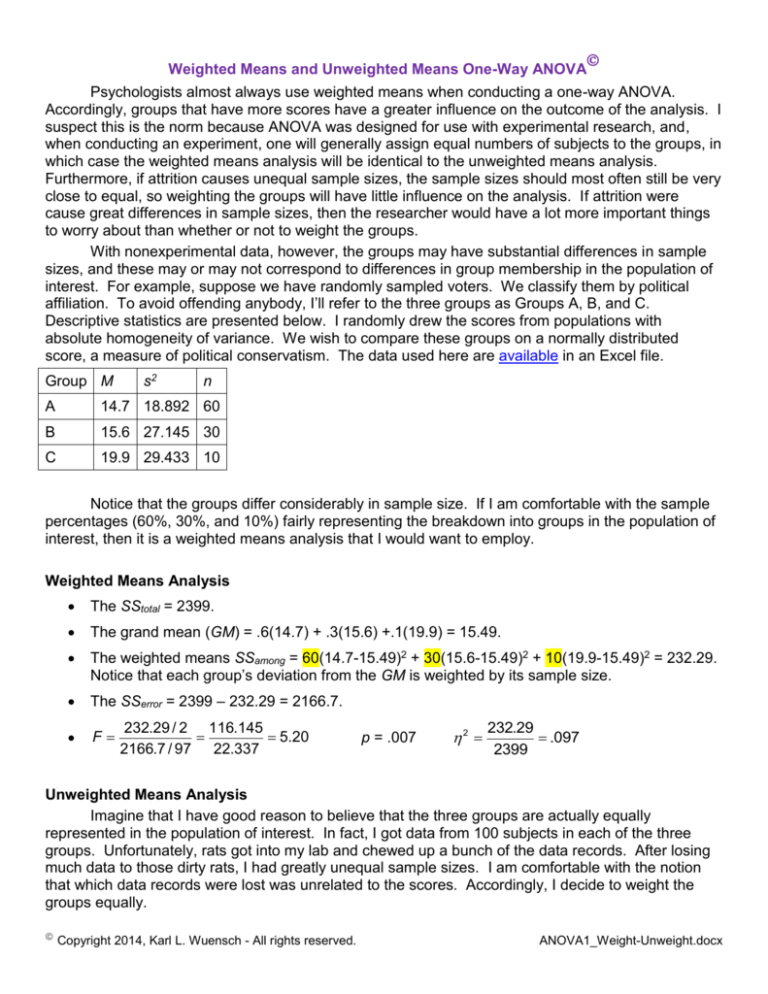
Weighted Means and Unweighted Means One-Way ANOVA
Psychologists almost always use weighted means when conducting a one-way ANOVA.
Accordingly, groups that have more scores have a greater influence on the outcome of the analysis. I
suspect this is the norm because ANOVA was designed for use with experimental research, and,
when conducting an experiment, one will generally assign equal numbers of subjects to the groups, in
which case the weighted means analysis will be identical to the unweighted means analysis.
Furthermore, if attrition causes unequal sample sizes, the sample sizes should most often still be very
close to equal, so weighting the groups will have little influence on the analysis. If attrition were
cause great differences in sample sizes, then the researcher would have a lot more important things
to worry about than whether or not to weight the groups.
With nonexperimental data, however, the groups may have substantial differences in sample
sizes, and these may or may not correspond to differences in group membership in the population of
interest. For example, suppose we have randomly sampled voters. We classify them by political
affiliation. To avoid offending anybody, I’ll refer to the three groups as Groups A, B, and C.
Descriptive statistics are presented below. I randomly drew the scores from populations with
absolute homogeneity of variance. We wish to compare these groups on a normally distributed
score, a measure of political conservatism. The data used here are available in an Excel file.
Group M
s2
n
A
14.7 18.892 60
B
15.6 27.145 30
C
19.9 29.433 10
Notice that the groups differ considerably in sample size. If I am comfortable with the sample
percentages (60%, 30%, and 10%) fairly representing the breakdown into groups in the population of
interest, then it is a weighted means analysis that I would want to employ.
Weighted Means Analysis
The SStotal = 2399.
The grand mean (GM) = .6(14.7) + .3(15.6) +.1(19.9) = 15.49.
The weighted means SSamong = 60(14.7-15.49)2 + 30(15.6-15.49)2 + 10(19.9-15.49)2 = 232.29.
Notice that each group’s deviation from the GM is weighted by its sample size.
The SSerror = 2399 – 232.29 = 2166.7.
F
232.29 / 2 116.145
5.20
2166.7 / 97 22.337
p = .007
2
232.29
.097
2399
Unweighted Means Analysis
Imagine that I have good reason to believe that the three groups are actually equally
represented in the population of interest. In fact, I got data from 100 subjects in each of the three
groups. Unfortunately, rats got into my lab and chewed up a bunch of the data records. After losing
much data to those dirty rats, I had greatly unequal sample sizes. I am comfortable with the notion
that which data records were lost was unrelated to the scores. Accordingly, I decide to weight the
groups equally.
Copyright 2014, Karl L. Wuensch - All rights reserved.
ANOVA1_Weight-Unweight.docx
3
20.
1/ 60 1/ 30 1/ 10
The harmonic mean sample size is nh
The variance of the means is VAR(14.7, 15.6, 19.9) = 7.723
MSamong nh sm2eans 20(7.723) 154.47 . Notice that this is the same formula we used to
compute the among groups mean square with equal sample sizes, except for the use of the
harmonic mean sample size.
SSamong = 2(154.47) = 308.94.
Typically the groups are not equally weighted when estimating the error variance (which is
assumed to be constant across populations), so the SSerror = same as from the weighted
means analysis, 2166.7. To get this by hand you would simply calculate the sums of squares
within each group and then sum them. Do note that this will result in the total sum of squares
not being equal to the sum of the among groups sums of squares and the error sum of
squares.
F
308.94 / 2 154.47
6.915
2166.7 / 97 22.337
2
308.94
.129
2399
Notice that the F and the 2 are larger than they were with the weighted means analysis. This
is because the group which differed most from the grand mean (Group C) had the smallest sample
size, and thus the least influence, in the weighted means analysis. When we went to unweighted
(equally weighted) means, the influence of this group increased.
Which Analysis Should I Use ?
If you are comfortable with the assumption that the unequal sample sizes fairly reflect the
composition of the population of interest, then the weighted means analysis is appropriate. If, for
whatever reason, you feel that the groups should be equally weighted, use the unweighted means
analysis – for example, if in experimental research one group had a much smaller sample size just
because it was very expensive to provide the treatment for that group, you might well be justified in
using an unweighted means analysis – but good luck finding a stat package that will do it for you.
With experimental research, in most cases, the sample sizes will not differ enough for type of analysis
to matter much.
Differently Weighted Means Analysis.
Suppose that the sample sizes were 10, 30, and 60, so that the group (C) with the greatest
deviation from the GM also had the largest sample size, and thus greater influence on the solution.
The grand mean (GM) = .1(14.7) + .3(15.6) +.6(19.9) = 18.09.
The weighted means SSamong = 10(14.7-18.09)2 + 30(15.6-18.09)2 + 60(19.9-18.09)2 = 497.49.
Notice that each group’s deviation from the GM is weighted by its sample size.
The SSerror = 2399 – 497.49 = 1901.5.
F
497.49 / 2 248.745
11.136
2166.7 / 97
22.337
2
497.49
.207
2399
Notice that the F and the 2 are now much larger than they were before.
Factorial Designs
With factorial designs, the distinction between weighted and unweighted means becomes
more important. Even with experimental data where subjects were randomly assigned to treatments,
there may be unequal cell sizes because of random attrition. Unless the cell sizes are proportional,
which is unlikely, these unequal cell sizes will result in the independent variables (factors) not being
independent of each other. This correlation among the factors will result in there being proportions of
the variance in the dependent variable (Y) which we cannot unambiguously say are due solely to one
effect (main effect or interaction effect). We want to know what the results would have been if the
factors were orthogonal. Since we experimentally manipulated the factors and randomly assigned
subjects to treatments, the treatments really should be orthogonal. The mathematical solution most
often (almost always) adopted here, these days, is to use Type III (Overall & Spiegel Method I) sums
of squares, which do not allocate to any effect variance which cannot be unambiguously credited to
that effect. The (now old-fashioned) unweighted means analysis was developed as an attempt to
approximate (doing the analysis by hand) the more complicated Type III analysis that is now easily
accomplished with computers and statistical software.
Some statisticians have argued that if the cell sizes are proportional but unequal, then it does
not matter whether you do the weighted or the unweighted means analysis. With proportional cells
sizes, the factors will, in fact, be independent of one another, as demonstrated by conducting a
contingency table analysis on the sample sizes – the resulting chi-square statistic will have a value of
zero. However, if there are interactions, the results of the weighted means analysis will differ from
those of the weighted means analysis.
Keppel (1973, pp 346-350, briefly laid out how to conduct a weighted means analysis for the
one-way layout.
VassarStats has an online calculator that will do a one-way ANOVA for you, weighted or
unweighted means. For the data used here, here is the unweighted means analysis computed using
the VassarStats calculator:
Reference
Keppel, G. (1973). Design and analysis. Englewood Cliff, NJ: Prentice Hall.
Copyright 2014, Karl L. Wuensch - All rights reserved.
Fair Use of This Document



